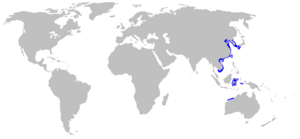Zebra bullhead shark facts for kids
Quick facts for kids Zebra bullhead shark |
|
|---|---|
 |
|
| Conservation status | |
| Scientific classification | |
| Genus: |
Heterodontus
|
| Species: |
zebra
|
 |
|
| Range of zebra bullhead shark (in blue) | |
The zebra bullhead shark (Heterodontus zebra) is a type of bullhead shark. It belongs to the Heterodontidae family. You can find these sharks in the central Indo-Pacific ocean. This area stretches from Japan and Korea all the way to Australia.
These sharks usually live in shallow waters, about 50 meters (164 feet) deep. However, off the coast of Western Australia, they can be found much deeper, between 150 and 200 meters (492 to 656 feet). A zebra bullhead shark can grow up to 1.25 meters (about 4 feet) long. They reproduce by laying eggs, which means they are oviparous.
Contents
What is a Zebra Bullhead Shark?
The zebra bullhead shark is part of the bullhead and horn shark family. Sometimes people call it the zebra horn shark or striped bullhead shark. They get their "bullhead" name from the strong, bony ridges above their eyes, which look a bit like a bull's brow.
These sharks have been around for a very long time. Their fossil records show they existed close to the beginning of the Mesozoic era. That's the time when dinosaurs lived!
Zebra bullhead sharks are not usually caught for food or sport. But their unique and cool striped patterns make them popular in aquariums around the world. These sharks are carnivores, meaning they eat meat. They hunt for creatures like sea urchins and crabs. They find their food in rocky reefs and kelp forests, which are their homes.
These sharks don't have many natural enemies in the ocean. Sometimes, larger sharks might hunt them. Humans can also be a threat to them.
How Does the Zebra Bullhead Shark Look?
The zebra bullhead shark has a slender, oval-shaped body. It looks a bit like a ray. Their snout, which is their nose area, is short and rounded. They don't have side teeth on their snout. Their eyes are on the top-sides of their head, with those bony crests above them.
They have two dorsal fins (on their back) and one anal fin (on their belly). Each dorsal fin has a spine inside it. The first dorsal fin is quite tall when the shark is young. As it grows into an adult, this fin becomes moderately high. The top of their body can be white or cream in color.
These sharks have five large gill openings on the sides of their head. These are slightly in front of their pectoral fins (the fins near their chest). The first gill slit is the biggest and closest to the front. The smallest gill slit is the one furthest back.
The most striking feature is their stripes! They have many vertical brown and black stripes. These stripes run from their snout all the way to their tail fin. A shark between 64 and 122 centimeters (2 to 4 feet) long can have 22 to 36 stripes. Their fins often have black tips, or their dorsal fin tips might be white.
How Big Do They Get?
The biggest zebra bullhead shark ever recorded was about 122 centimeters (4 feet) long. When they hatch from their eggs, baby sharks are at least 15 centimeters (about 6 inches) long.
Male zebra bullhead sharks become adults when they are between 64 and 84 centimeters (2 to 2.7 feet) long. Female sharks need to be larger, reaching about 122 centimeters (4 feet) to become fully mature.
Reproduction and Life Cycle
Zebra bullhead sharks reproduce by laying eggs. This is called being oviparous. A female shark usually lays two eggs at a time. This happens during spring and late summer, often near the coast of Japan.
During one mating season, a female shark might lay eggs six to twelve times. She usually places her eggs in rocky areas or in fields of kelp. The embryos, or baby sharks, grow inside the eggs. They feed on a yolk, which is like their food supply. The eggs hatch about a year after they are laid. The baby sharks that hatch are typically around 18 centimeters (7 inches) long.
The mating process starts with the male shark gently holding onto the female's pectoral fin. Then, the male inserts a special organ called a clasper into the female.
Human Impact on Zebra Bullhead Sharks
Zebra bullhead sharks grow slowly. This makes it hard for scientists to study them in labs. Because they grow and reproduce slowly, human actions can have a big impact on them.
These sharks are important to humans in a few ways. They are part of the aquarium trade, as mentioned before. Scientists also study them to learn more about marine life and how different species affect each other.
People are working to protect these sharks. Laws have been made in parts of Asia to help protect this species and its close relatives. The zebra bullhead shark is currently listed as "Least Concern" by the IUCN Red List. This means they are not in immediate danger. However, more information is needed to fully understand how humans are affecting these amazing creatures.


